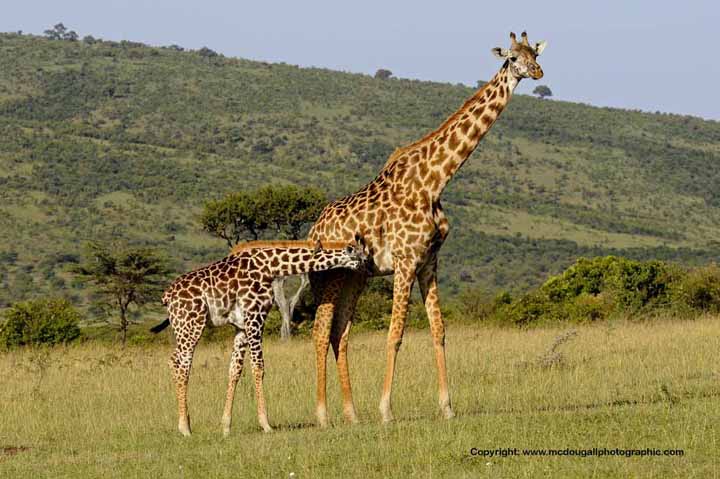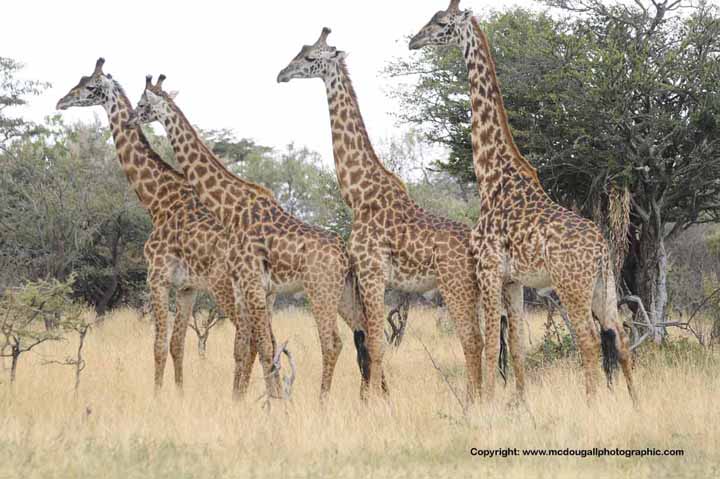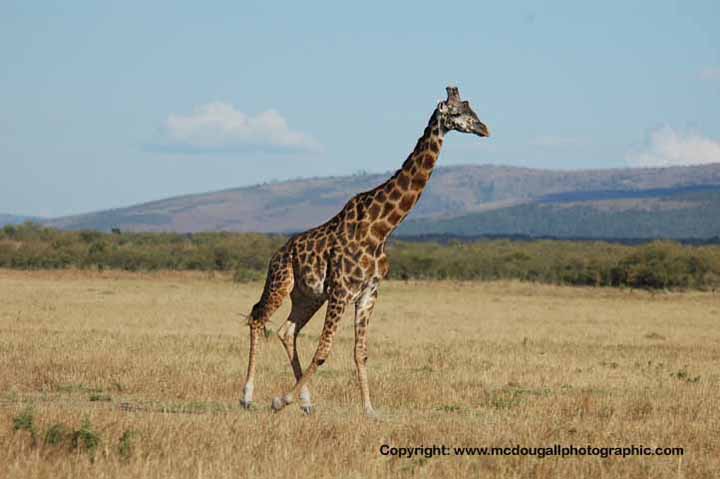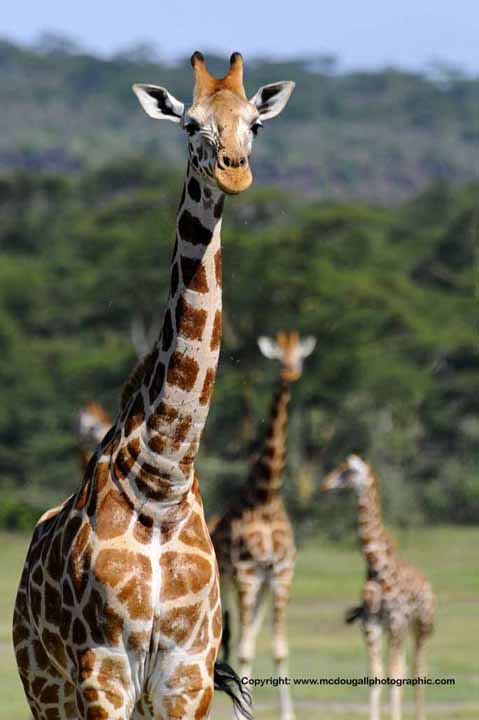Adventure
Photographs and text by
Paul McDougall
Kenya has many beautiful natural wonders. It is teeming with wildlife. It has many National Parks and Reserves including Lake Nakuru National Park, Amboseli National Reserve, Tsavo National Park, Samburu National Reserve and the most famous Masai Mara National
Reserve.
All of the big 5 are found in Kenya. The big 5 are so named because they were considered the most challenging animals to hunt in colonial times and also the heads of these animals made the most impressive and sought after trophies. The big 5 are Lions, Leopard,
Elephant, Rhino and Buffalo.
The Giraffe is the tallest of African mammals. The male can grow up to 5.5 metres tall and the female up to 4.5 metres tall. In Kenya there are 3 different species of Giraffe. The Masai Giraffe founf in Masai Mara, The edangered Rothschilds Giraffe found in
Lake Nakuru and the Reticulated Giraffe found in Samburu, all species have different markings and distinct patterns to their coats.

Masai Giraffe calf suckling
I have seen and photographed all 3 sub species of giraffe in Kenya, but the Masai Giraffe is probably my favorite. Giraffe can be very difficult to photograph, they often don’t do much and trying to get an interesting shot can be hard. One day we were driving
to Masai Mara, and not even in the reserve we came across a group of over 50 Giraffe, but it was the way that some were behaving that was so bizarre. We watched as some of the group stood in a line and proceeded to mount each other, it was the strangest of
sites seeing a line of giraffes doing this. I managed to get photographs of them doing this several times and 2 males necking and sparring with each other. I can honestly say that we spent an hour watching these giraffe, which is the longest I have ever spent.
This encounter just sums up how amazing our natural world is, and how unpredictable it can be. It just proves that if you think an animal is not that interesting to photograph, you always need to be prepared for something to challenge that pre-conception.
Growing tall gave the giraffe access to a 2m band of foliage beyond reach of any other large herbivore apart from the elephant, it is aided by its 45cm tongue. Browsing by giraffes can have big effects on their food trees, pruning of young trees keeps them
short for years longer than usual and makes waste bands around taller trees whose tops are beyond reach. Various species of the thorny acacia form the majority of their diet. The giraffe is protected when feeding on the sharp thorny trees by having a narrow
muzzle, extremely flexible upper lip and long prehensile tongue, these features enable it to strip leaves off branches or select individual leaves and shoots from in between thorns, therefore it can feed selectively and consume the 34 kg of vegetation per
day that it needs to sustain its bulk. Giraffes may drink at intervals of 3 days or less when water is available, but also get a lot of the moisture that they need through eating green leaves. Giraffes are gregarious and non territorial – they can form large
groups of over 50, however the groupings tend to be temporary and casual.

Masai Giraffe herd
A Giraffe has a very unusual walk – when walking it puts all the weight on the left side with both legs moving together and then all of the weight on the right with the right legs moving together. At a gallop the forefeet and the hindfeet work together in pairs,
even when travelling at 50-60kph the giraffe is so long legged that it looks like it is moving in slow motion.

Masai Giraffe running
Giraffes have a long gestation period of 14 – 14.5 months, most conceptions occur during the rains when vegetation is at its most plentiful. Giraffes due to their great size, superior vision, speed and formidable hooves make them largely invulnerable to predators,
although lions if able to get a throat or nose hold are able to bring them down. Small calves however are very vulnerable to lions and hyenahs. As detailed above the three species of giraffes in Kenya can be seen in the parks detailed, The Rothschilds giraffe
can also be seen at the Giraffe Sanctuary in Nairobi, which has been set up to conserve these endangered animals, here it is possible to feed and stroke these beautiful animals whilst contributing towards conserving them.

Rothschilds Giraffe
Kenya has many National Parks and Reserves, Nairobi NP is one of over 30 areas which have been set aside by the Kenyan Government to conserve what remains of the plentiful wildlife which roamed freely across the savannah of Africa. The sound of Lions can still
be heard in Nairobi NP which borders the modern capital city. It is here that many visitors have their first taste of the amazing varied wildlife Kenya has to offer.
Kenya can boast the largest and the smallest National Parks and Reserves in East Africa. Tsavo covers an area of 20,500 square km (making it larger than Israel), Saiwa Swamp is just 1.9km squared and was established especially to conserve the rare Sitatunga
Antelope. Kenya also has Masai Mara the jewel in the crown – the 7th wonder of the world where millions of Wildebeest and Zebra migrate from Serengeti in Tanzania, one of the few places where mass amounts of animals can be witnessed as in days gone by, this
is one of the most filmed and written about Natural areas in the world, a visit here in migration time will never disappoint.
A visit to Kenya can offer so many diverse and amazing habitats from the coast to Mt Kenya, from savannah to swamp, from desert to Forest there is something for everyone. It really is like nowhere on earth.
|